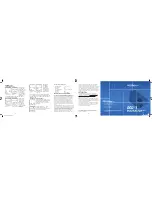
Figure 22
5. Place the small hole of the UTM roamer scale over the “X”. (Fig 22)
- Make sure the scale is parallel to the drawn easting and northing grid lines.
6. Count from the “X” to the nearest
left
easting line - 100, 200, ... 500 &
600 m
.
7. Add 600 m to the nearest
left
easting line.
- 600m E + 599000m E =
599600m E
8. Count from the “X” to the nearest northing line,
below
-- 100, 200, ... 700 &
750 m
.
9. Add 750 m to the nearest northing line,
below
the “X”.
- 750m N + 4790000m N =
4790750m N
The final UTM coordinate is:
zone 11 599600m E 4790750m N datum: NAD-27
Before entering the coordinate into a GPS receiver, select NAD-27 as the local geodetic datum on your
GPS receiver. This allows the GPS receiver to “speak the same language as the map.” If NAD-27 is
unavailable, or local geodetic datum is unknown, select World Geodetic System 1984 (WGS-84).
Note:
The 1:100k UTM scale is located on the latitude-longitude & UTM template. Using the 1:100k
scale, you will measure easting same as you did above, then you must rotate the scale to measure
northings. Remember, place zero at the position (“X”).
9.1.b -- Plotting a GPS Position On a Map
Your GPS receiver says your location is:
6
01
600m
E
47
90
300m
N zone 11 using: NAD-27.
Now, you
would like to plot the position on a 1:24k topo-map.
1. Using the GPS position, you identify and circle the
1,000 meter UTM grid tick marks on the map: 6
01
and 47
90
. (Fig. 23)
Comparing the intersection of the 601 and 4790 lines
to the GPS position, you know your approximate
position is 600 m to the
right
and 300 m
up
, because
eastings always increase right, and northings always
increase up.
2. On the compass, identify 600m E and 300m N from the 1:24k UTM roamer scale. (Fig. 24)
Figure 23
8




























